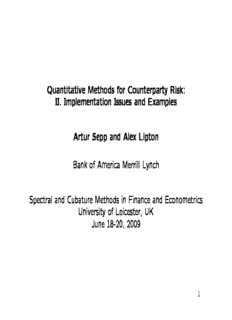
II. Implementation Issues and Examples Artur Sepp and Alex Lipton Bank of America Me PDF
Preview II. Implementation Issues and Examples Artur Sepp and Alex Lipton Bank of America Me
Quantitative Methods for Counterparty Risk: II. Implementation Issues and Examples Artur Sepp and Alex Lipton Bank of America Merrill Lynch Spectral and Cubature Methods in Finance and Econometrics University of Leicester, UK June 18-20, 2009 1 Plan of the presentation 1) Counterparty risk 2) Modelling aspects 3) FFT based methods in one dimension 4) PDE based methods in one dimension 5) PDE based methods in two dimensions 6) Illustrations 2 CDS basics Credit default swap (CDS) - provides to the buyer a protection against a reference name in return for coupon payments up to contract ma- turity or the default event At contract inception, the coupon is set so that the present value of CDS is zero As the time goes by, the mark-to-market (MtM) value of the CDS contract fluctuates In particular, when the credit quality of the reference name worsens, the MtM increases 3 Counterparty Risk When the CDS protection is sold by a defaultable counterparty, the protection buyer faces the risk of losing a part of the mark-to-market value of the CDS, if it is positive for the buyer, due to the counterparty default The loss is profound if the credit quality of both the reference credit and the counterparty worsen simultaneously but the counterparty de- faults first Counterparty risk is crucial at both the firm and economy wide levels (”domino effect”) 4 Counterparty Charge Let τ and τ be default times of the reference name and the coun- 1 2 terparty, respectively The counterparty charge, C(t), is the expected maximal potential loss due to counterparty default up to CDS maturity T: (cid:34) (cid:35) (cid:90) T (cid:110) (cid:104) (cid:105) (cid:111) E (cid:48) E ˜ (cid:48) (cid:48) (cid:48) C(t) = (1 − R ) D(t, t ) max C(t ) | E(t ) , 0 1 dt 2 t t(cid:48) {E(t(cid:48))} t (1) ˜ C(t) is cash flow of CDS contract (long protection) without counter- party risk discounted to time t E(t) = {τ > t, τ = t} 1 2 R is recovery rate of counterparty obligations 2 −(cid:82) T r(t(cid:48))dt(cid:48) D(t, T) = e t is the risk-free discount factor 5 Motivation Model for the counterparty risk evaluation need to: 1) describe realistic dynamics of CDS spreads (jump-diffusions) 2) create profound correlation effects (correlated jump-diffusions with simultaneous jumps) Model should match observable market data closely: 1) the term structure of CDS spreads 2) the term structure of discount factors 3) equity and CDS options volatilities 4) correlations Some of model parameters are made time-dependent to fit term struc- ture effects 6 Generic 1-d model a(t) - the value of the firm assets (stochastic) l(t) - the default barrier (deterministic) a(t) x(t) = ln - the log of the normalized asset value a(0) Assume that x(t) is an additive process with independent time-dependent increments (Sato (1999)): dx(t) = µ(t)dt + σ(t)dW(t) + jdN(t), x(0) = 0 (2) µ(t) = −κλ(t) is the compensator jumps have probability density function (cid:36)(j) The default time τ is defined by: l(0) τ = min{t : x(t) ≤ b}, b = ln , b < 0 a(0) The default is triggered either discretely (t ∈ {t }) or continuously d 7 Implications for model implementation 1) Ability to handle different pay-off structures in one and two di- mensions 2) Time dependent model parameters 3) Fast calibration through the forward induction 4) Pricing through the backward induction consistently with the for- ward induction Analytical methods are restrictive given the above considerations We concentrate on numerical methods to solve the problem effi- ciently: 1) FFT based methods 2) PDE based methods 8 Generic 1-d Problem. Backward Equation I U(t, x) is the value function of a generic product with maturity time T specified by: 1) terminal pay-off function given survival at T, u(x) 2) coupon function given survival at time t, c(t, x) 3) rebate function given default at time t, q(t, x) By Feynman-Kac Theorem: U (t, x) + LU(t, x) = −c(t, x), t U(T, x) = u(x), (3) U(t, x) = q(t, x), x ≤ b 9 Generic 1-d Problem. Backward Equation II L is the infinitesimal operator corresponding to dynamics (2): L = D + J (4) D is the diffusion-convection operator: 1 2 DU(t, x) ≡ σ (t)U + µ(t)U − (r(t) + λ(t))U xx x 2 J is the integral operator: (cid:90) ∞ J U(t, x) ≡ λ(t) U(t, x + j)(cid:36)(j)dj −∞ 10
Description: